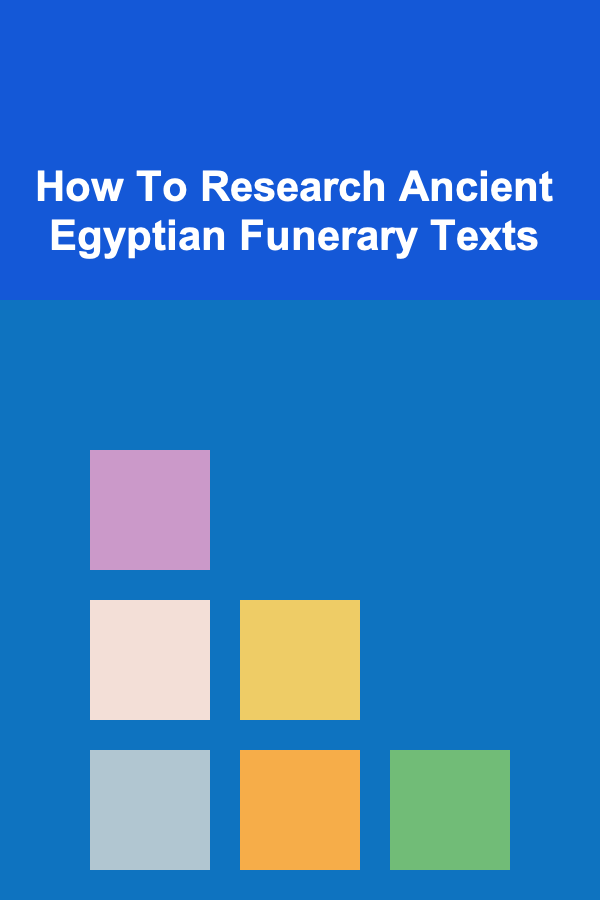
How To Research Ancient Egyptian Funerary Texts
ebook include PDF & Audio bundle (Micro Guide)
$12.99$8.99
Limited Time Offer! Order within the next:

Ancient Egyptian funerary texts are among the most significant and intricate pieces of literature and religious texts in the world's history. These texts provide invaluable insight into the religious beliefs, burial practices, and afterlife concepts of ancient Egyptians. These texts, which include spells, hymns, and prayers, were often inscribed on tombs, coffins, and papyri to assist the deceased in their journey to the afterlife. They not only offer glimpses into the ancient Egyptian worldview but also hold key information regarding their social structures, gods, and rituals. Researching these texts, however, requires a multifaceted approach that combines historical context, linguistic analysis, and archaeological evidence.
This article will explore the methodologies, tools, and resources needed to effectively research ancient Egyptian funerary texts. It will cover the fundamental elements, the types of texts you will encounter, and the steps you should take to delve into these ancient works. Through a deeper understanding of how to approach the study of these texts, researchers can unlock significant information about the beliefs and practices of one of the world's most fascinating ancient civilizations.
Understanding the Historical and Cultural Context
Before diving into the analysis of ancient Egyptian funerary texts, it's essential to establish a solid understanding of the historical and cultural context in which these texts were created. The civilization of ancient Egypt spanned thousands of years, and its burial practices evolved significantly during this time. To interpret funerary texts correctly, researchers must grasp the broader historical and religious developments that influenced their creation.
A. The Ancient Egyptian Afterlife Beliefs
One of the core themes in funerary texts is the ancient Egyptians' beliefs about death and the afterlife. Central to these beliefs was the concept of immortality, where the deceased's soul, or "ka," would continue to exist in the afterlife, provided certain rituals were performed. The ancient Egyptians believed that after death, the soul would travel through perilous trials to reach the Field of Reeds, a paradise-like afterlife. Funerary texts were designed to assist in this journey, offering protection, guidance, and provisions for the deceased.
B. The Evolution of Funerary Texts
Funerary texts did not remain static. They evolved over time, reflecting changes in religious practices, society, and the Egyptian understanding of death. In the early periods, the Pyramid Texts (c. 2400 BCE) were reserved for royalty and inscribed inside pyramids to protect the king's soul. As Egyptian society expanded, the Coffin Texts (c. 2000 BCE) made their way into the coffins of elite individuals. By the New Kingdom period (c. 1550-1070 BCE), the famous Book of the Dead, a compilation of spells and prayers, became widely used for individuals of all social classes. Understanding these developments helps researchers interpret the meanings and uses of different texts.
C. Religious and Political Influence
Ancient Egyptian funerary texts were not just religious documents; they also served political purposes. The relationship between the king and the gods was often depicted in these texts, with the king portrayed as a divine figure who had a crucial role in maintaining ma'at (cosmic order). Understanding the political context in which these texts were written, including the role of the pharaoh, the priesthood, and the elites, is crucial to understanding how these texts reflected both spiritual and social hierarchies.
Types of Funerary Texts
The term "funerary texts" encompasses a wide range of documents, each serving different purposes in assisting the deceased's journey to the afterlife. Below are some of the most important types of funerary texts researchers may encounter.
A. Pyramid Texts
The Pyramid Texts are the oldest known religious texts in ancient Egypt, dating back to the Old Kingdom period. These texts were inscribed on the walls of royal pyramids, primarily for the benefit of pharaohs. They consist of spells, hymns, and prayers that were intended to guide the deceased king through the afterlife and ensure his divine transformation. These texts are some of the most important early examples of Egyptian religious literature and form the foundation for later funerary texts.
B. Coffin Texts
The Coffin Texts, as mentioned earlier, evolved from the Pyramid Texts but were adapted for the elite non-royal individuals. These texts were inscribed on the inside of coffins and tombs, offering similar protection and guidance as the Pyramid Texts, but with a wider audience. The Coffin Texts are crucial for understanding how funerary beliefs and rituals were democratized over time, and they represent an important shift toward making afterlife texts accessible to a broader population.
C. The Book of the Dead
Perhaps the most well-known funerary text, the Book of the Dead was a compilation of spells and prayers that originated from the Coffin Texts but evolved into a more flexible and personalized document. Unlike the rigid formulas of earlier texts, the Book of the Dead was a set of texts that could be customized according to the individual's needs. It was often written on papyrus and placed in the tomb with the deceased, and it contained spells to help the deceased navigate challenges in the afterlife, like the Judgment of the Dead and encounters with dangerous gods. The Book of the Dead became widely used during the New Kingdom and beyond, and many surviving papyri provide valuable insights into the beliefs and practices of ordinary Egyptians.
D. Funerary Stelae
In addition to texts written inside tombs, there were also funerary stelae---stone tablets that often contained inscriptions commemorating the deceased and invoking prayers or spells. These stelae could be erected in tombs or burial sites and served as a public form of remembrance and invocation. Stelae can also provide valuable historical and genealogical data, especially in the later periods of Egyptian history.
E. Tomb Inscriptions
Tomb inscriptions are another category of funerary texts that researchers will encounter. These inscriptions, often found on the walls of tombs, provide a record of the deceased's life, achievements, and family. Some tomb inscriptions also contain spells and prayers for the protection of the deceased. They can vary greatly in length, detail, and style, depending on the period and the individual's social status.
Research Methodology
Researching ancient Egyptian funerary texts involves several interconnected steps. The process can be intricate, as it requires knowledge of languages, script, archaeology, and religious studies. Below are some strategies to effectively research these texts.
A. Learning Hieratic and Demotic Script
Funerary texts, especially those from the New Kingdom onward, were often written in hieratic or demotic scripts. Hieratic was a cursive form of hieroglyphs used for religious texts, while demotic was a simplified script used in daily life and administrative documents. Researchers need a solid understanding of these scripts to read and analyze the texts. For those unfamiliar with the Egyptian writing systems, it is essential to learn the basics of these scripts.
Many universities offer courses in Egyptology that include studies in hieratic and demotic. Several textbooks, including Middle Egyptian: An Introduction to the Language and Culture of Hieroglyphs by James Peter Allen, provide a solid foundation in understanding the language and script.
B. Analyzing Texts in Context
When researching funerary texts, it is essential to place the text in its historical, cultural, and archaeological context. This involves not only examining the script itself but also considering the material culture of the time, including the architecture of tombs, the artifacts found within them, and the larger religious practices of the period. Funerary texts cannot be fully understood in isolation; they must be analyzed as part of a larger framework of Egyptian religion, society, and culture.
Archaeological excavations often yield inscriptions or fragments of funerary texts that may be incomplete or fragmented. Researchers must be prepared to work with partial texts and piece them together to form a coherent understanding of the text's meaning and purpose.
C. Comparative Analysis of Texts
Because funerary texts evolved over time, researchers should compare different types of texts from various periods. For example, comparing the Pyramid Texts with the Coffin Texts, or the Book of the Dead with later funerary inscriptions, reveals changes in the beliefs and practices associated with death and the afterlife. A comparative approach also helps scholars understand the evolution of Egyptian language, religious ideas, and social structures.
D. Consulting Published Research and Databases
The field of Egyptology has a long history of research, and many ancient Egyptian funerary texts have already been translated, published, and analyzed. Consulting existing scholarship is essential to avoid reinventing the wheel and to ensure that you are building upon the work of previous researchers.
Several important databases, such as the Thesaurus Linguae Aegyptiae (TLA) and the Electronic Text Corpus of Sumerian Literature (ETCSL), contain digitized versions of ancient texts that can be used for comparison and analysis. These resources are invaluable for those researching funerary texts.
Conclusion
Researching ancient Egyptian funerary texts is a fascinating and complex endeavor that provides profound insight into the religious and cultural practices of one of the world's oldest civilizations. By understanding the historical context, recognizing the various types of texts, and employing effective research methodologies, scholars can unlock the mysteries of ancient Egyptian beliefs surrounding death and the afterlife.
While these texts are challenging to study due to their language, script, and fragmentary nature, the rewards of researching them are immense. The study of funerary texts not only illuminates ancient Egyptian religion but also offers a glimpse into the broader worldview of one of history's most influential cultures.

How to Choose Your Wedding Dress and Bridesmaid Dresses
Read More
How to Keep Your Sheet Music in Good Condition
Read More
How to Protect Your Garage from Break-ins and Theft
Read More
How to Provide Clear Instructions for Camp Activities
Read More
How to Stage Your Home's Dining Area for Family Gatherings
Read More
How to Use Under-Sink Storage for Kitchen and Bath
Read MoreOther Products

How to Choose Your Wedding Dress and Bridesmaid Dresses
Read More
How to Keep Your Sheet Music in Good Condition
Read More
How to Protect Your Garage from Break-ins and Theft
Read More
How to Provide Clear Instructions for Camp Activities
Read More
How to Stage Your Home's Dining Area for Family Gatherings
Read More